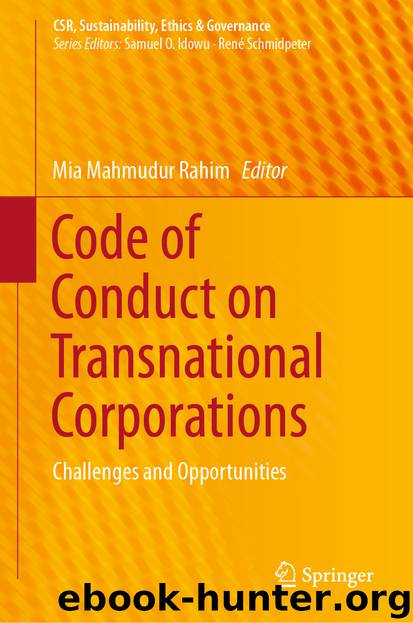Code of Conduct on Transnational Corporations by Mia Mahmudur Rahim

Author:Mia Mahmudur Rahim
Language: eng
Format: epub
ISBN: 9783030108168
Publisher: Springer International Publishing
6.2 Case 2: 25 June 2013 “Business for Peacebuilding” Conference
After the creation of the Guidance Document, there was a need to create a partnership between the UNGC and the main bodies of the UN in the field of peace and security. Regarding the theory of Global Governance, the following three factors are indispensable: (1) Global Norm: the sum of laws, norms, policies, and institutions; (2) Transnational Relations: mediation of trans-border relations; and (3) Multilateral Actors: states, citizens, intergovernmental and nongovernmental organizations, and the market (Weiss and Thakur 2010, pp. 31–32). The Guidance Document is super soft, but we can say that it is the Global Norm. The UNGC itself has the nature of a transnational network (Transnational Relations). As seen in case 1, the norm-creating process of the Guidance Document involves a multi-stakeholder process that includes multilateral actors such as citizens, intergovernmental and nongovernmental organizations, and the market, who all participate in the process of peacemaking and peacebuilding.14 In 2004, not only the UNGC but also the UNSC discussed this issue, expanding it to include civil society in the process of peacebuilding (UNSC 2004, 2005). At the meeting of the Security Council, one of the representatives from the NGOs mentioned that “Engagement with civil society is not an end in itself, nor is it a panacea, but it is vital to our efforts to turn the promise of peace agreements into the reality of peaceful societies and viable States. The partnership between the United Nations and civil society is therefore not an option; it is a necessity” (UNSC 2004, p. 4). Furthermore, in this UNSC meeting the importance of businesses in the process of peacebuilding was discussed. Businesses can, with their local partners, mobilize the will of broad economic and social sectors. Businesses can offer financial support for productive quick-impact projects, for example through employment initiatives for former combatants (ibid., p. 19). The UN, the UNSC and the PBC perceived that an important role for the UN was to convene, facilitate, and lead partnerships not only of governments, but also of all stakeholders including civil society and businesses so that multi-stakeholder processes (MSPs) could become key elements in the field of peace and security. Brozska et al. (2011, p. 259) state that “MSPs are not only a promising but also already an effective instrument for improving human security and development.”
Even if the importance of partnerships between the inter-governmental bodies of the UN (such as the UNSC or the PBC) and non-state actors was understood, few partnerships between the UNGC and the PBC have actually been created. In 2007, the Permanent Mission of Japan to the UN sought to establish a partnership with civil society. As Uhlin (2010, p. 16) note, it was a very important issue to include non-state actors and MSPs in UN governmental meetings. Even if non-state actors were included in peacebuilding activities on the ground in post-conflict countries, it was not satisfactory for the whole peacebuilding process to be carried out without including such non-state actors in the PBC at the headquarters of the UN in New York.
Download
This site does not store any files on its server. We only index and link to content provided by other sites. Please contact the content providers to delete copyright contents if any and email us, we'll remove relevant links or contents immediately.
International Integration of the Brazilian Economy by Elias C. Grivoyannis(91947)
The Radium Girls by Kate Moore(11930)
Turbulence by E. J. Noyes(7942)
Nudge - Improving Decisions about Health, Wealth, and Happiness by Thaler Sunstein(7622)
The Black Swan by Nassim Nicholas Taleb(7016)
Rich Dad Poor Dad by Robert T. Kiyosaki(6414)
Pioneering Portfolio Management by David F. Swensen(6230)
Man-made Catastrophes and Risk Information Concealment by Dmitry Chernov & Didier Sornette(5926)
Zero to One by Peter Thiel(5692)
Secrecy World by Jake Bernstein(4652)
Millionaire: The Philanderer, Gambler, and Duelist Who Invented Modern Finance by Janet Gleeson(4386)
The Age of Surveillance Capitalism by Shoshana Zuboff(4216)
Skin in the Game by Nassim Nicholas Taleb(4165)
Bullshit Jobs by David Graeber(4101)
The Money Culture by Michael Lewis(4083)
Skin in the Game: Hidden Asymmetries in Daily Life by Nassim Nicholas Taleb(3935)
The Dhandho Investor by Mohnish Pabrai(3706)
The Wisdom of Finance by Mihir Desai(3659)
Blockchain Basics by Daniel Drescher(3511)
